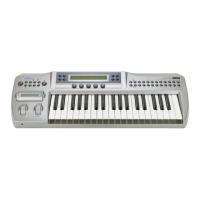3.5
Moving the cursor
in
Performance Editor
Define,
Pattern
Define
mode,
and
Edit
mode
2 3
A
5
One page can contain
up
to five parameters. To move the cursor to the parameter you wish to edit,
use the
CURSOR<>
keys
or
rotate the knob for that parameter.
If
you rotate the knob, be aware
that the value of the parameter will also be affected.
3.6
Setting
values
in
Performance
Editor
Define,
Pattern
Define
mode,
and
Edit
mode
.........
,,
f
...
[
..
·"''
.....
,
:.
:
I'::·
..
:::
::
..
::
-:.
j
Rotate the knob nearest the parameter you wish to edit,
and
the value will change.
or
5
or
VAlUE
+
00
Press the VALUE
+I-
keys
to modify the value of the
parameter
at
the cursor in
steps
of+
1/-1.
00000000000
a
...
UP
DOWN
ALT
I
ALT
2 RANDOM
PAT1
PAT2
PAT:J
PAT.&
PATS
0
....
1-1
Use the numeric keys to enter a value for the parameter at the cursor. The numeral printed in the
lower row below each key indicates the value that will be entered.
If
the parameter value is a signed number (positive
or
negative),
use
the PATTERN/PROGRAM
Select key to
input
positive(+) or
negative(-)
values.
If
the range of values
is
within 0-9, a single press of a numeric key will finalize the input.
If
the range of values is two
or
more digits, the place of the numeral will scroll as you enter more
digits,
and
the value will be finalized
when
you press the ENTER key.
If the ENTER key
LED
blinks
when
you modify a value, press the ENTER
key to finalize the value. To cancel the change, press the
EXIT
key.
3.7
About
the
screen
display
• Performance mode
If
in Performance Editor Define
or
Edit
mode
you
have modified a
parameter
value, the bank
name
of
the modified
program
will be displayed in lower-case characters (a,b,c). When you Write the
data
into
memory, this will
return
to the upper-case display.
For
other
aspects of the display, refer to
"About
the Performance
mode
display" (page
8)
and
"About
the Performance Editor display" (page 11).
Lower-case display indicates that the program has been edited.
21'

